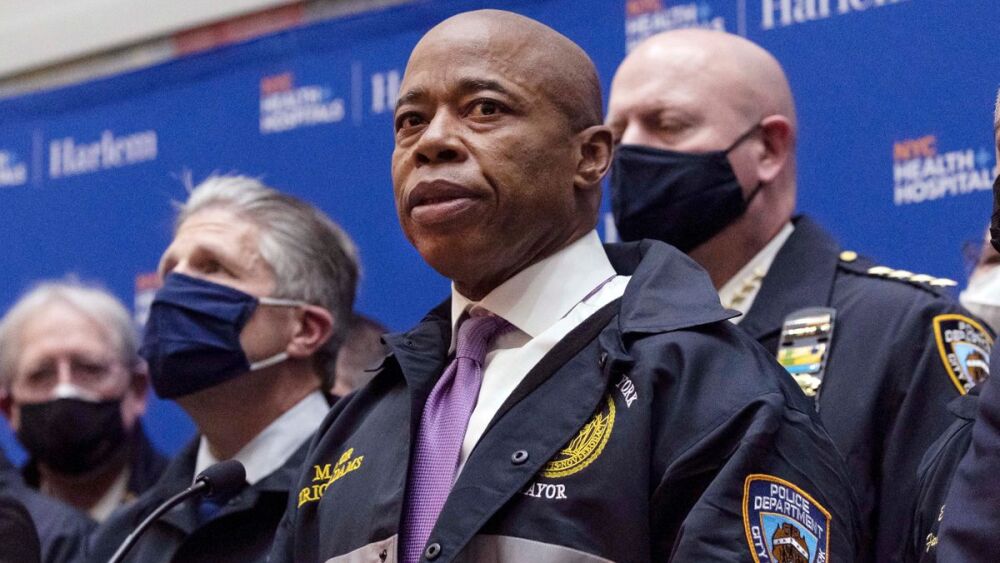By Joseph Ostapiuk
Staten Island Advance, N.Y.
STATEN ISLAND, N.Y. — Mayor Eric Adams focused heavily on one of his signature campaign issues — the city’s response to crime — during the reveal of his 2023 fiscal budget proposal Tuesday at the historic Kings Theatre in Brooklyn.
The $99.7 billion budget price tag represented nearly a $2 billion increase from his previous proposal in February, and shed light on some of Adams’ plans to combat a surge in crime that has plagued the five boroughs.
The mayor’s plan does not represent the final step in the budget process, which will continue with negotiations with the city council that stretch into June, just before the city’s 2023 fiscal year begins.
“In our first 100 days, crime and tragedy took far too many lives in our city,” said Adams, a former police officer. “There is still far too much violence in our communities.”
Adams reaffirmed support for his “Blueprint to End Gun Violence,” an effort that lays out several immediate and long-term policies aimed at addressing the scourge of guns on the city’s streets, and announced added resources to his multi-agency “Subway Safety Plan” centered on the issue of homelessness.
Raising funding for his plan to combat the proliferation of guns on city streets, Adams said, includes strategic focus and realistic solutions to target the “small number of individuals responsible for the majority of gun trafficking and shootings in our city.”
[EARLIER: Man arrested in Brooklyn subway attack faces federal terrorism charges]
That approach is not one New York City is tackling alone, added Adams, who noted that law enforcement agencies at the local, state and federal level are working to cut off the stream of illegal weapons into the five boroughs.
Adams’ executive budget offers a $171 million investment in 1,400 shelter beds and three new drop-in centers for homeless individuals, according to a summary of his proposal.
Additionally, funds will be provided for expanded subway outreach services, a city Department of Health neighborhood response unit and expanded street health outreach and wellness programming at Health + Hospitals, said Adams.
The mayor said New Yorkers should expect a visible difference in the deployment of the city’s cops in the subway in the coming weeks “to get those officers who are not doing a job to join those officers who are doing their job.”
Expressing frustration at the deployment of cops within the city’s traffic hubs, Adams said he no longer wants to see officers idly standing at turnstiles. He recollected back to his time as a cop patrolling the city’s subway and said he wants current officers to replicate those efforts by being present within the train.
A Staten Island man was stabbed and nearly killed aboard a Manhattan subway train earlier this month, underscoring an uptick in crime in the city’s subway system.
“We’re going to start taking very aggressive actions to make sure police are patrolling our subway system and not patrolling the iPhone,” said Adams.
A dedicated gun crime unit in the city’s Office of the Medical Examiner is included in Adams’ latest proposal to speed up DNA analysis to fight back against the scourge of shootings the five boroughs have recently experienced.
Part of Adams’ multi-faceted plan to address public safety concerns is included in what he bills as “upstream solutions” to combatting crime.
“These investments we are making in our most vulnerable brothers and sisters will help keep them and our entire city safe because public safety is not just about police,” said Adams. “It’s about people.”
The city’s B-HEARD (Behavioral Health Emergency Assistance Response Division) program, which was previously piloted in select precincts throughout the city and uses paramedics instead of police to address mental health emergencies, received a boost from Adams’ budget pitch.
Adams said the budget includes $55 million to expand the initiative, which is also part of the subway crime plan. High-needs neighborhoods in the central Brooklyn, eastern Queens and the south Bronx will be added to the program’s purview.
“Not every emergency call needs police,” said Adams Tuesday. “B-HEARD teams de-escalate tense situations and connect people in crisis to the care they need.” Those teams can call police to scenes if assistance is needed.
The NYPD received increased funding in Adams’ budget proposal, who added the monetary commitment is “not spending; this is investing.” The total, according to Adams, was largely affected by contractual agreements with detectives within the department and overtime hours.
The exact details of the department’s funding in Adams’ plan was not available early Tuesday afternoon.
(c)2022 Staten Island Advance, N.Y.


